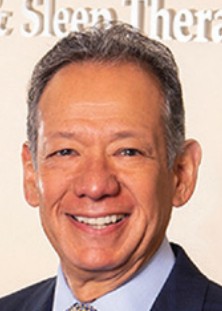Dr. Steven Olmos offers some facts and underscores the urgency to treat sleep disorders as soon as possible.
An editorial focus of this issue is sleep and, importantly, the comorbid consequences of sleep pathology. The most common sleep pathology is insomnia, the inability to get to sleep or to get back to sleep after arousal — the transition from deeper to lighter sleep via stimulation of the sympathetic nervous system associated with bruxism and orofacial pain. The relationship between chronic pain and sleep is profound. Sleep and pain have a bidirectional effect on each other. The less sleep people have, the more pain they feel, and chronic pain disrupts their sleep.1 Sleep complaints are present in 67% to 88% of chronic pain disorders,2,3 and at least 50% of individuals with insomnia suffer from chronic pain.4 The frequency of interrupted sleep relates to the degree of daytime fatigue, making the AI (arousal index) as or more important than AHI (apnea hypopnea index). Each time a person is aroused from sleep, cortisol is produced, which results in vascular oxidative stress (VOS) triggering vascular inflammation, the mechanism of cardiovascular disease. This is true for adults and children. VOS results in increased clotting of the blood, which leads to stroke and heart attack.
Chronic disturbance in sleep leads to psychosocial symptoms of anxiety and depression.5 Chronic pain is linked to depression.6 Though anxiety is not linked to TMD, findings show depression to be linked.7 Treating sleep-breathing disorders has been shown to reduce psychosocial symptoms.8
Unconscious collapse of the pharyngeal airway by obstructive sleep apnea (OSA) and central sleep apnea (CSA) are the most frequent sleep-breathing disorders. The four components of OSA are critical pressure to collapse the pharyngeal airway: (P-crit), muscle tonus or recruitment, loop gain (response to apnea-transition to breathing), and arousal threshold (how long it takes be awakened to begin breathing). P-crit and muscle tonus can be affected by oral appliances, surgery, medications, positive pressure, orthopedic development in children, and myofunctional therapy. Findings show that myofunctional therapy reduces OSA by 50% in adults and 62% in children.9 Loop gain and arousal threshold are neurologic conditions. CO2 sensitivity is the main factor in these mechanisms. They are treated with medications and nasal breathing training and exercises.
Dr. Christian Guilleminault, the seminal figure in sleep medicine and developer of the AHI system, stated that the ultimate goal in the treatment of sleep apnea is the transformation of oral breathing to nasal both day and night.10 The findings of soon to be published research reveal that nasal obstruction (specifically nasal valve compromise [NVC]) show a significant comorbidity with capsulitis (OR 3.73) and facial and cervical myositis (OR 6.97). NVC has been found to have an odds ratio of 6.97 comorbid with orofacial pain.
Proper orthopedic development should be started as soon as a breathing disorder is identified for optimal quality of life.
- Finan PH, Goodin BR, Simth MT. The association of sleep and pain: An update and a path forward. J Pain. 2013;14(12):1539-1552.
- Morin CM, LeBlanc M, Daley M, Gregoire JP, Merette C. Epidemiology of insomnia: prevalence, self-help treatments, consultations, and determinants of help-seeking behaviors. Sleep Med. 2006;7(2):123-130.
- Smith MT, Haythornthwaite JA. How do sleep disturbance and chronic pain inter-relate? Insights from the longitudinal and cognitive-behavioral clinical trials literature. Sleep Med Rev. 2004;8(2):119-132.
- Taylor DJ, Mallory LJ, Lichstein KL, Durrence HH, Riedel BW, Bush AJ. Comorbidity of chronic insomnia with medical problems. 2007;30(2):213–218.
- Ancoli-Israel S. The impact and prevalence of chronic insomnia and other sleep disturbances associated with chronic illness. Am J Manag Care. 2006;12(suppl 8):S221–S229.
- Sheng J, Liu S, Wang Y, Cui R, Zhang X. The Link between Depression and Chronic Pain: Neural Mechanisms in the Brain. Neural Plast. 2017; 2017:9724371.
- Reiter S, Emodi-Perlman A, Goldsmith C, Friedman-Rubin P. Comorbidity Between Depression and Anxiety in Patients with Temporomandibular Disorders According to the Research Diagnostic Criteria for Temporomanibular Disorders. J Oral Facial Pain Headache. 2015;29(2):135-143.
- Johal A, Battagel J, Hector M. Controlled, prospective trial of psychosocial function before and after mandibular advancement splint therapy. Am J Orthod Dentofacial Orthop. 2011;139(5):581-587.
- Camacho M, Cetal V, Abdullatif J, et al. Myofunctional Therapy to Treat Obstructive Sleep Apnea: A Systematic Review and Meta-analysis. 2015; 38(5):669-675.
- Guilleminault C, Sullivan SS. Towards Restoration of Continuous Nasal Breathing as the Ultimate Treatment Goal in Pediatric Obstructive Sleep Apnea. Enliven: Pediatr Neonatal Biol. 2014;1(1).
Stay Relevant With Orthodontic Practice US
Join our email list for CE courses and webinars, articles and mores

 Steven Olmos, DDS, has been in private practice for more than 30 years with the past 25 years devoted to research and treatment of craniofacial pain and sleep-related breathing disorders. He obtained his dental degree from the USC School of Dentistry and is Board Certified in both chronic pain and sleep-breathing disorders by ABCP, ABDSM, and ABCDSM. Dr. Olmos is the founder of TMJ & Sleep Therapy Centres International with over 60 licensed locations in seven countries dedicated exclusively to the diagnosis and treatment of craniofacial pain and sleep disorders.
Steven Olmos, DDS, has been in private practice for more than 30 years with the past 25 years devoted to research and treatment of craniofacial pain and sleep-related breathing disorders. He obtained his dental degree from the USC School of Dentistry and is Board Certified in both chronic pain and sleep-breathing disorders by ABCP, ABDSM, and ABCDSM. Dr. Olmos is the founder of TMJ & Sleep Therapy Centres International with over 60 licensed locations in seven countries dedicated exclusively to the diagnosis and treatment of craniofacial pain and sleep disorders. 
